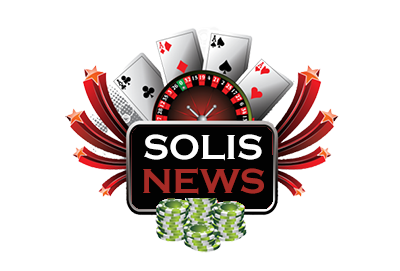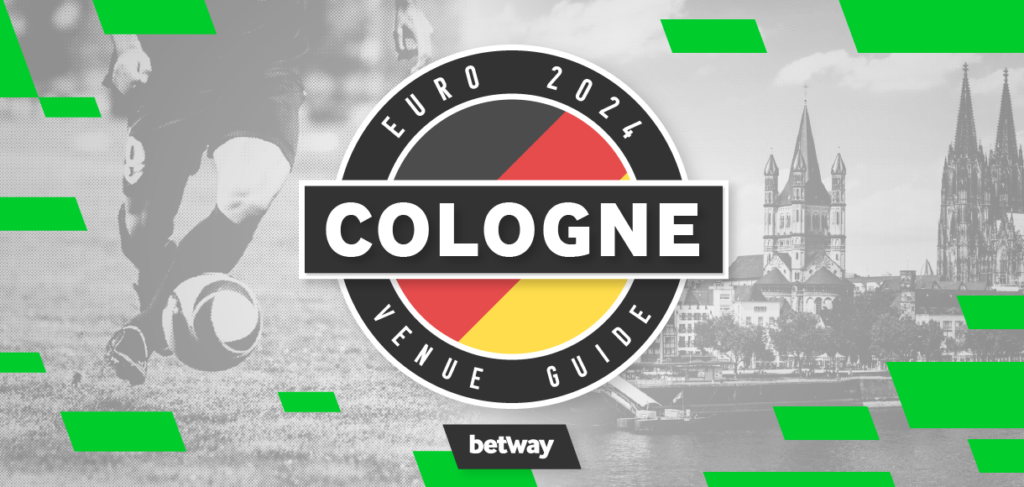Ready to head to Cologne for this summer’s Euro fixtures? Learn all about this historic city and the incredible games lined up, with our in-depth city guide.
With summer already on the horizon, it’s safe to say that football fans are just a little bit excited for this year’s big tournament – Euro 2024!
Set to be a breathtaking event that’s sure to deliver some incredible goals and memorable moments from Europe’s best teams, we wouldn’t blame you if you were already raring to go – which is exactly why we’ve pulled together this in-depth guide for anyone staying in Cologne for Euro 2024.
From touching down and experiencing the games to top tips on what to see in Cologne between matches, explore all there is to know about visiting this historic German city, as part of our complete Euro 2024 guide. Alternatively, explore the latest Euro 2024 odds.
In this Cologne travel guide we’ll cover:
· Which Euro 2024 matches are being held in Cologne?
· Visiting Cologne’s RheinEnergieSTADION
· Where is the Euro 2024 fan zone in Cologne?
· How to get from Cologne airport to the city centre
· Where to stay in Cologne for Euro 2024
· How to travel around Cologne
· Where to eat in Cologne
· Cologne’s most picturesque photo spots
· The best day trips from Cologne
· Final things to know before visiting Cologne for the Euros
· Explore the other Euro 2024 host cities
Which Euro 2024 matches are being held in Cologne?
While not necessarily the main city for Euro 2024 (that honour naturally goes to Berlin), Cologne still gets the privilege of hosting 5 of the tournament’s total games from June 15th to June 30th.
This includes one Round of 16 fixture, as well as England’s Group C match against Slovenia and Scotland’s Group A match against Switzerland. The full set of Euro 2024 fixtures in Cologne include:
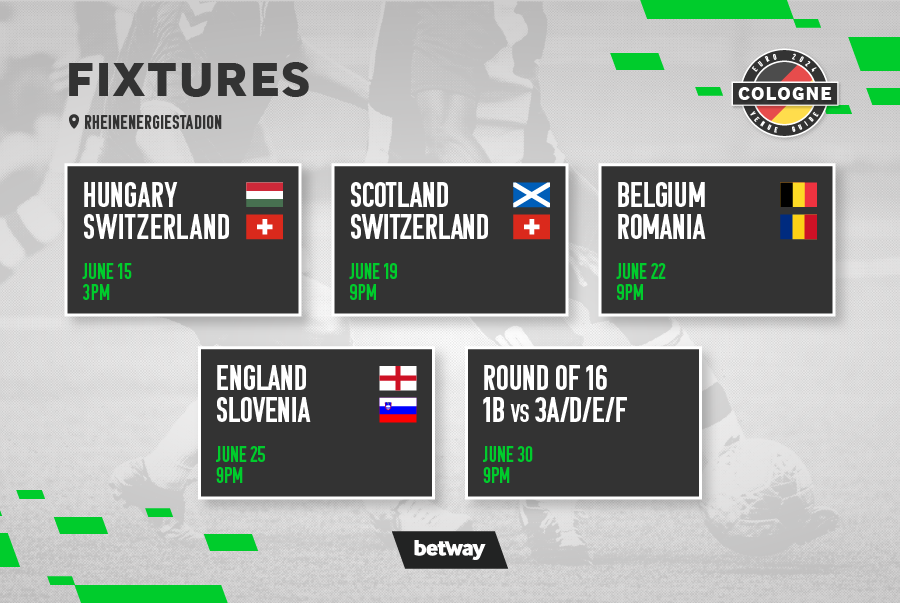
Visiting Cologne’s RheinEnergieSTADION
Housed in the Müngersdorf area of Cologne, the RheinEnergieSTADION boasts a seating capacity of around 43,000 fans. Just 6km from Cologne city centre, it’s easily accessible by public transport.
How to get to the RheinEnergieSTADION
To get to RheinEnergieSTADION, you’ll likely catch Tram Line 1 from Neumarkt station in the city centre to Weiden. This will take you straight to the RheinEnergieSTADION stop in just 15 minutes. From here, it’s then a 5-minute walk to the stadium.
Where to park at the RheinEnergieSTADION
Although it’s possible to reach Cologne’s football stadium by car, it’s strongly recommended that you take the tram to get to the RheinEnergieSTADION – especially on matchdays – as the central traffic in Cologne can be exceedingly busy throughout the day.
On top of this, the RheinEnergieSTADION only has a limited number of parking spots in general, all of which must be pre-booked in advance. These parking passes typically costs €24 per match and are sold on a first come first served basis.
However, if you do have to drive, we’d suggest parking further out from the stadium in one of the many available parking zones and then either walking to the venue or taking public transport. Though if you do require disabled parking, the RheinEnergieSTADION can accommodate this.
RheinEnergieSTADION history
The RheinEnergieSTADION actually holds the honour of being the third stadium on this historic site, having been rebuilt from the 1975 Müngersdorf Stadion in order to host matches for the 1988 UEFA European Championship – and subsequently the 2006 World Cup.
However, the history of Cologne’s football heritage actually dates all the way back to 1923, which saw the construction of its very first football stadium: Sportpark Müngersdorf.
Nowadays though, the RheinEnergieSTADION is best known for being the home of three-time national champions, 1. FC Köln. A multi-purpose venue, as well as Bundesliga football, the arena’s also hosted American football games, hockey, and even live music from the likes of Pink and The Rolling Stones!
Best RheinEnergieSTADION selfie spots
Naturally, we couldn’t talk about Cologne’s stadium without mentioning the best locations to take those essential matchday selfies – the kind that’ll make your friends back home wish they’d also grabbed a ticket for the big game.
From showing off the RheinEnergieSTADION’s incredible architectural design to highlighting the local history, here are the spots in the stadium where you should be snapping those Instagram pics:
· RheinEnergieSTADION Entrance: The walk up to the RheinEnergieSTADION boasts an impressive view, especially as you stroll through the avenue towards the stadium main entrance, making it a must-visit spot for stadium selfies. Or, alternatively, flip you phone around and grab a shot of you and your friends under the Stadion Avenue sign!
· Under the Frames: The RheinEnergieSTADION is blessed with a unique and dynamic framework exterior that’s fascinating to look at; and it also makes for a great backdrop when taking angled selfies before going inside.
· FC-Museum: Like many German stadiums, the RheinEnergieSTADION is home to its very own club museum, so you’ll have plenty of opportunities to snap photo of yourself besides some of the club’s most iconic pieces of history.
And don’t forget, to take a moment to catch those matchday-ready group shots from your seats. That way, you can permanently capture the moment.
Refreshments at the RheinEnergieSTADION
If you’re visiting Cologne for Euro 2024, expect reasonably priced refreshments. As an example, during the regular season, you can expect to pay just €3.30 for a basic bratwurst and €4.30 for a standard soft drink. This places the RheinEnergieSTADION as the cheapest venue for hot dogs, and the third-cheapest for drinks, compared to other host arenas.
RheinEnergieSTADION rules
Like all sporting venues, the RheinEnergieSTADION has several rules and restrictions in place that you’ll need to abide by if you want to enjoy your day out. We’ve flagged the essential ones to be aware of below:
· Bags: While bags are allowed within the stadium, they can’t be bigger than an A4 piece of paper. Any bags larger than this will need to be left in your accommodation or car as there is no luggage drop-off point in this venue.
· Power banks: Small power banks are allowed within the stadium; however, these must be no bigger than your phone.
· ID: Regardless of where you’re seated in the stadium, you must have a valid form of ID on you at all times, such as your passport or driver’s license.
· Cameras: Professional cameras are not allowed within this venue, but by all means capture the moment on your mobile.
· Smoking: As with all Euro 2024 stadiums, Cologne’s RheinEnergieSTADION is a smoke-free zone. This includes a ban on the use of e-cigarettes.
· Flags: Fans are allowed to bring in flags that are a maximum of 1m long, as well as banners that are a maximum of 2m x 1.5m in size.
Before arrival, it’s important to familiarise yourself with the regulations!
Where is the Euro 2024 fan zone in Cologne
The Euro 2024 festival is taking place across all of Germany’s host cities, and Cologne is no exception. With the Euro 2024 fan zone being located in the Heumarkt, supporters will have plenty of things to do in Cologne throughout the tournament – all while immersing themselves in the local culture.
How to get to the Euro 2024 fan zone in Cologne
Nestled right in the heart of Cologne’s city centre, the Heumarkt actually has its very own station, so all you need to do is find the next tram or metro heading there and hop on.
Cologne Euro 2024 fan zone entry requirements
As with most Euro fan zones, there is little in the way of entry requirements when visiting, with entry being free for everyone throughout the full length of the tournament.
Euro 2024 fan zone activities
Open for the full 31 days of the Euros, Cologne’s fan zone is set to host a range of exciting activities, from a myriad of football challenges where you can show off your skills to DJ sets and a fully fleshed-out entertainment programme.
In short, there’ll be plenty of things to do in Cologne – not to mention the fantastic food and drink that’ll be available in the fan zone and around the nearby area!
Other places to watch Euro 2024 in Cologne
As exciting as it is to watch big games at the free public viewing area, you might prefer to catch the match in a local pub or bar. With this in mind, some of the best sports bars in Cologne include:
· Jameson Pub Cologne (4.6-rated on Google, from 3,900+ reviews)
· Joe Champs (4.3-rated on Google, from 2,300+ reviews)
· Barney Vallely’s (4.6-rated on Google, from 1,200+ reviews)
How to get from Cologne airport to the city centre
When travelling to Cologne, you’ll likely land at Cologne Bonn Airport. From here, you can reach the city centre by train or taxi:
· Train: Cologne Bonn Airport has a direct train to Cologne city centre. It takes just 45 minutes to get to the stadium and only 25 minutes to reach Cologne Central Station.
· Taxi: For a more personal and less packed trip to the city, you’ll be able to either book ahead of time or flag down directly one of the many taxis that call Cologne home. Fares are fixed for Cologne’s taxis, meaning you won’t get any sudden surprises at the end of your journey. Alternatively, you can book an UBER or BOLT straight from your phone if you’re worried about the language barrier.
Alternatively, while there are direct flights to Cologne Bonn Airport, you could also choose to land at Cologne Messe or Deutz, both of which have transfer options to local public transport, such as the S-Bahn and U-Bahn, to get you into the centre of Cologne.
Where to stay in Cologne for Euro 2024
Before arriving in Cologne, you’re obviously going to want to know where you’re staying, especially if you want to tailor your stay to your taste and make some lasting memories. The good news is that Cologne is home to many varying districts, each with their own unique feel and flavour.
Examples of some of the best places to visit in Cologne include:
Kalk
The budget option for anyone looking to save money on their stay, Kalk is located on the east side of the river, well away from Cologne’s tourist area and major city attractions – making it perfect for those after a quieter stay and plenty of rest.
Lindenthal
Ideal for those who want to wake up as close to Cologne’s stadium as possible, and therefore be in the centre of the action straight away.
Lindenthal is nestled in a residential area just to the west of the city centre. But it’s not just for stadium goers: with plenty of local eateries, Lindenthal has quite the café culture, as well as a lively evening atmosphere thanks to being close to the University of Cologne campus.
Altstadt
Also known as ‘Old Town’, Altstadt is the landmark capital of Cologne, being home to both Cologne Cathedral and the Hohenzollern Bridge, alongside many other features. Separated into Altstadt-Nord and Altstadt-Süd, you’ll have plenty of choices when it comes to hotels and Airbnbs.
Ehrenfeld
If there’s one thing many German cities are known for, it’s their nightlife. So, if that’s something you’re interested in sampling after the day’s game, then you should look for accommodation in the Ehrenfeld area. It’s practically buzzing with shops, restaurants, trendy cocktail bars, and nightclubs.
Heumarkt
Finally, if you want to be near the fan zone and core public transport links of the main city, then Heumarkt is an excellent choice. Technically located within Altstadt, the Heumarkt area specifically is surrounded by restaurants and pubs that are perfect for relaxing on a lazy afternoon.
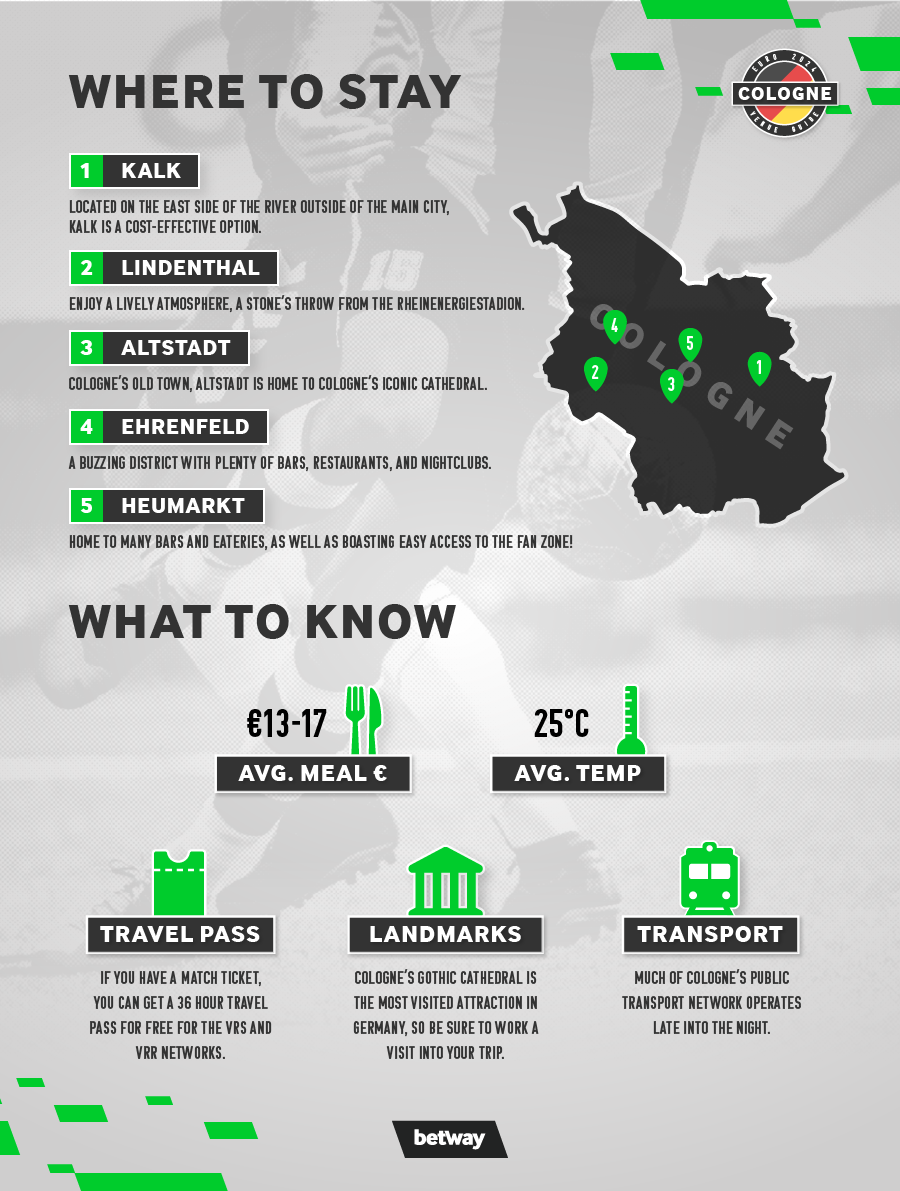
How to travel around Cologne
With Germany having a well-earned reputation for excellent transport, it should come as no surprise that Cologne has many public services that you can use to get around the city:
· Tram: As we’ve flagged several times, Cologne has a well-run tram network that can get you from A to B at a moment’s notice.
· Bus: Traffic can get pretty hectic in Cologne’s centre, but if you want the cheapest travel services, then Cologne’s many bus routes are your best option.
· U-Bahn: Germany’s specialised underground metro service has plenty of lines throughout Cologne, with many services operating until 1am for those enjoying the nightlife.
· S-Bahn: Much like the U-Bahn, the S-Bahn offers a similar service, but operates above ground as well as under, with plenty of access points around the city.
· Ferry: An unexpected addition to any public transport system, but one that’s more than welcome, Cologne has a free ferry that takes people between Old Town and Cologne Deutz, should you want to cross the river at your leisure.
Alternatively, while Cologne’s public transport network is certainly well developed, its streets are also incredibly pedestrian-friendly. In fact, Cologne is so well tailored towards pedestrians that you can practically walk to all the main tourist spots, shopping zones, and sports venues.
Cologne public transport tips and tricks
Even though Cologne has a highly efficient and easily accessible public transport network, that’s not to say there aren’t a couple of bonus tricks to be aware of to make getting around as seamless as possible:
· Book early: Even when it’s not hosting the Euros, Cologne’s public transport network is known for getting busy. So, if you need to get a specific train, book in advance if you want a seat.
· Validate your ticket: In order to use your U-Bahn or S-Bahn ticket, you will need to validate it at one of the red or yellow validation machines on the platform. If you don’t validate it before travel, it won’t be considered valid by a conductor, and you may have to pay a fine if caught.
· Buy before you travel: No matter what train or metro service you’re getting, you will need to buy your ticket before you travel, as there is no way to buy them once you’ve boarded.
· VRS app: The VRS app lets you purchase individual tickets for many of Cologne’s public transport services, and its “eezy” function allows you to ride and check out at your leisure, auto-calculating ticket prices as you go, so you don’t need to worry about having the exact change.
· Travel pass: If you have a match ticket, you get a 36 Hour Travel Pass for free for the VRS (Verkehrsverbund Rhein-Sieg) and VRR (Verkehrsverbund Rhein-Ruhr) networks, which will be valid from 6am on matchday to 6pm the next day. This even covers travel to other nearby host cities outside of Cologne, such as Gelsenkirchen and Dortmund.
· Night services: Much of Cologne’s public transport network operates late into the night, making it easy for you to get back to your accommodation when you’ve finished celebrating your team’s latest victory.
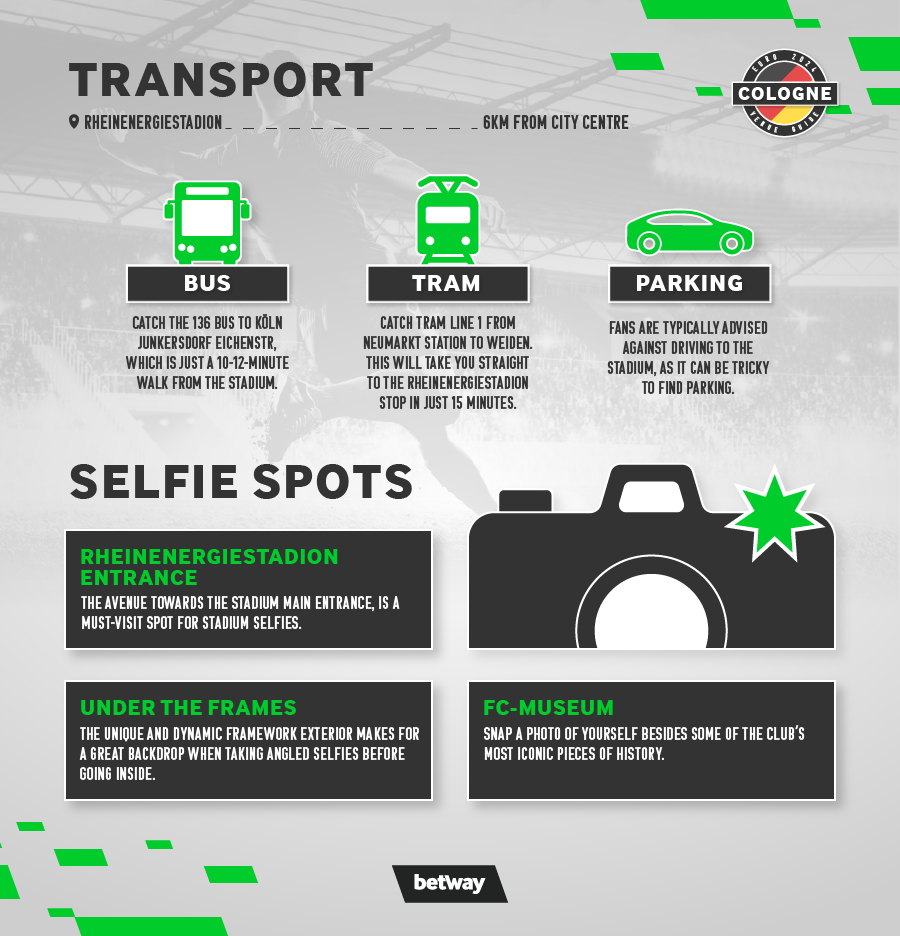
Where to eat in Cologne
A quintessential part of any holiday, dining out is a must while visiting Cologne. Widely considered one of Germany’s best gastronomic experiences, there’s an incredible selection of delicious food options available for all dietary preferences.
Best of all, eating and drinking in Cologne is relatively affordable, with the average lunchtime meal costing around €17 (and that includes buying a drink).
And speaking of eateries, if you’re looking for some interesting places to satiate your hunger without breaking the bank, we’ve taken the liberty of highlighting several well-regarded restaurants in Cologne offering a variety of popular cuisines:
· German: If sampling traditional German and Austrian food is something you have down on your ‘What to do in Cologne’ list, then look no further than Gruber’s. Offering a cosy indoor aesthetic and a romantic outdoor terrace if you want to steal a romantic evening with your significant other, it holds an excellent rating of 4.7-stars on Google from a total of 900 reviews.
· Italian: Let’s face it, who doesn’t love a hand-crafted pizza or carefully seasoned pasta dish from time to time? And if that’s what you have a hankering for, then Ristorante il Tartufo is widely considered one of the best Italian restaurants in Cologne. A fairly priced, light-filled restaurant with wood-fired ovens, it’s earned itself a rating of 4.8-stars from 1,200 reviews.
· Greek: Interested in sampling a Mediterranean dish while away? Restaurant Athens boasts a rating of 4.4-stars from 1,100 reviews and offers classic Greek mezes skewers and meaty grills with a tavern feel – complete with an exposed brick aesthetic and sidewalk seating.
· Burgers: Simple and satisfying, at the end of the day, if you want a decent burger, then you need to head to Freddy Schilling – Die Hamburger Manufaktur. In the running for Cologne’s best burger restaurant, Freddy’s has garnered 3,000 reviews overall, for a rating of 4.5-stars.
· Vietnamese: Finally, if you’re tastebuds are after something a little more exotic, then 1980 – Café und Bánh Mi Köln is perfect for anyone eager for Asian dishes. A small but well-regarded café, its Vietnamese cuisine has helped win it a rating of 4.7-stars from 800 reviews.
The best döner kebabs in Cologne
The humble döner is incredibly popular in Germany – it’s certainly the go-to takeaway choice for many footy fans – and with many kebab houses spread around Cologne, you certainly won’t have trouble finding one.
However, if you want the best döner kebabs in Cologne, you should check out the following establishments:
· Lunke Kebap Haus: 4.7-rated on Google, from 375 reviews
· Kudret Kebap House: 4.7-rated on Google, from 4,600+ reviews
· Sülzer Kebab: 4.5-rated on Google, from 498 reviews
· Mangal Doner Resturant: 4.5-rated on Google, from 2,300+ reviews
· Pizza & Döner Mediterrane: 4.5-rated on Google, from 993 reviews
Cologne’s most picturesque photo spots
Steeped in a rich historical culture, Cologne is absolutely brimming with potential photo spots that you can visit to fill your Instagram with.
Whether that’s snapping your friends in front of the many ancient architectural buildings or spending time lining up the perfect shot down one of the old town’s quaint side alleys, some of the most popular things to see in Cologne include:
· The Fischmarkt: Possibly Cologne’s most well-known Instagram spot in the city, the Fischmarkt is surrounded by eye-catching and brightly coloured houses, with its most-noticeable skyline being dominated by the spires of the impressive St Martins Church. For an empty picture, it’s best to visit early in the morning; though if you want to capture the hustle and bustle of daily German life, then head down in the afternoon when all the local café chairs and tables have been laid out.
· Rheingarten: One of Cologne’s many stunning parks, the Rheingarten is particularly notable for being one of the few spots in the city where you can take a photo that will encompass the entirety of Cologne Cathedral in a single shot.
· Cologne Cathedral: The most visited attraction in Germany and a UNESCO world heritage site since 1996, Cologne’s spectacular gothic cathedral holds an impressive façade and interior that is just perfect for photos, and that’s before you even see the view from atop its spires. It’s one of the many essential things to do in Cologne, no matter how long you’re visiting for.
· Cologne Cable Car: Offering a slow and picturesque crossing of the Rhine River, with panoramic views of the old town and the beautiful city surroundings, Cologne’s cable car is ideal for a cosy selfie with your partner that includes a stunning background.
· The Hohenzollern Bridge: One of Cologne’s most impressive bridges, and just a stone’s throw away from its cathedral, the Hohenzollern Bridge viewing platform is the best spot to capture a shot of Cologne Cathedral at sunset.
The best day trips from Cologne
As much as you could spend the entirety of your trip’s spare time exploring everything that the city has to offer, we’d really be doing the local region a disservice if we didn’t also highlight some of the more interesting day trips from Cologne, such as:
· The Ahr Valley: An absolute must-visit for any wine lovers, the Ahr Valley is quite literally filled with vineyards as far as the eye can see. So, if you have a spare afternoon, why not take a slow hike along the Red Wine Trail? You might even get a chance to sample some of the local vintages.
· Brühl: A town located in the Rhineland that’s just a little outside of Cologne, Brühl is home to both the Augustusburg and Falkenlust palaces, which are UNESCO world heritage sites and impressive structures to tour.
· Düsseldorf: Boasting some of Germany’s most distinct and phenomenal architecture, Dusseldorf is an incredible city to look at on a visual level and is packed with intriguing museums and sightseeing opportunities. It’s also very easy to get to by train, with direct connections running from Cologne Central Station.
· Bonn: Another village located along the Rhine River, Bonn is a former Roman settlement. Some interesting facts about Bonn: it was the birthplace of Beethoven, and it operated as the former capital of West Germany before The Wall fell!
· Schloss Drachenburg: Its name might be a mouthful for non-natives, but that doesn’t stop this enchanting villa from being a must-see tourist destination. Situated above the town Königswinter in the Siebengebirge, you can tour the villa at your leisure before taking in the stunning views as you walk around the local area.
Final things to know before visiting Cologne for the Euros
Last, but not least, now that you know what to look forward to when visiting Cologne, it’s worth touching on a few last-minute but important things to know before you begin your Euros trip.
Weather in Cologne
Being at the centre of Europe, Germany benefits from having a rather continental climate – it’s neither particularly warm nor cold throughout the year, with summer highs of around 25 degrees. However, that’s not to say Cologne hasn’t experienced summer heat waves in the past, so be sure to bring a bottle of sunscreen, just in case.
Language
While no one expects you to become fluent in German before arriving in Cologne, knowing a little bit of the local language will go a long way towards endearing you to the locals. Below are just a few useful phrases to know while you’re there:
· Hallo (Hello)
· Bitte (Please)
· Tschüss (Bye!)
· Danke (Thanks)
· Entschuldigung (Excuse me)
· Sprechen sie Englisch? (Do you speak English?)
· Ich verstehe nicht (I don’t understand)
However, don’t panic if you’re worried people won’t be able to understand you on your trip. Cologne has the fourth-highest number of English speakers in Germany, so it’s a safe bet you’ll be able to chat with the locals while you’re there.
Tipping
Much in the same way that adding a touch of German to your speech while you’re there will be very much appreciated, so too will be making sure you have some physical cash on you for tipping at restaurants.
Tipping is typically customary in most restaurants and bars, with the bill often being rounded up and a modest tip being left for good service.
Hospitals in Cologne
Ideally, you shouldn’t have any reason to visit one of Cologne’s many hospitals while you’re out enjoying yourself. But on the off-chance you find that you or someone else needs medical attention, you can get in touch with the emergency services on 122, or visit any of the following nearby hospitals:
· Cellitinnen-Krankenhaus St. Marien: The most centrally located hospital in Cologne, it has a 24-hour emergency department.
· Eduardus Hospital: Centrally located on the east side of the river, Eduardus will likely be your closest option if you’re near the Kalk area.
· St. Elisabeth-Krankenhaus Köln-Hohenlind: Located close to Lindenthal and the stadium, this hospital has a 24-hour emergency department.
· Cellitinnen Krankenhaus St. Franziskus: Another hospital near the stadium, the location also operates a 24-hour emergency department.
Explore the other Euro 2024 host cities
With our handy travel guide and comprehensive list of things to do in Cologne, you should have no problem navigating the city during Euro 2024 . And if you’re planning on city-hopping throughout the tournament, be sure to check out our other guides which explore the things to see in each of the other host locations:
· Berlin
· Dortmund
· Hamburg
· Leipzig
· Munich
